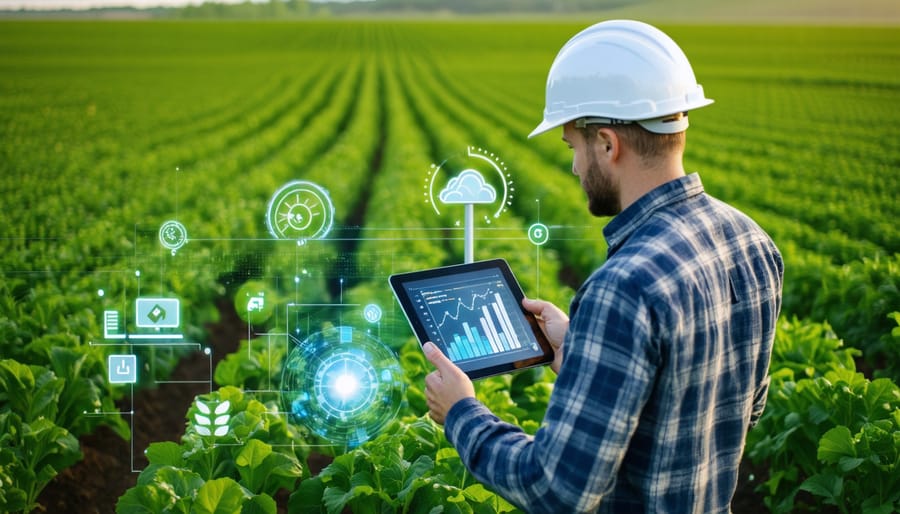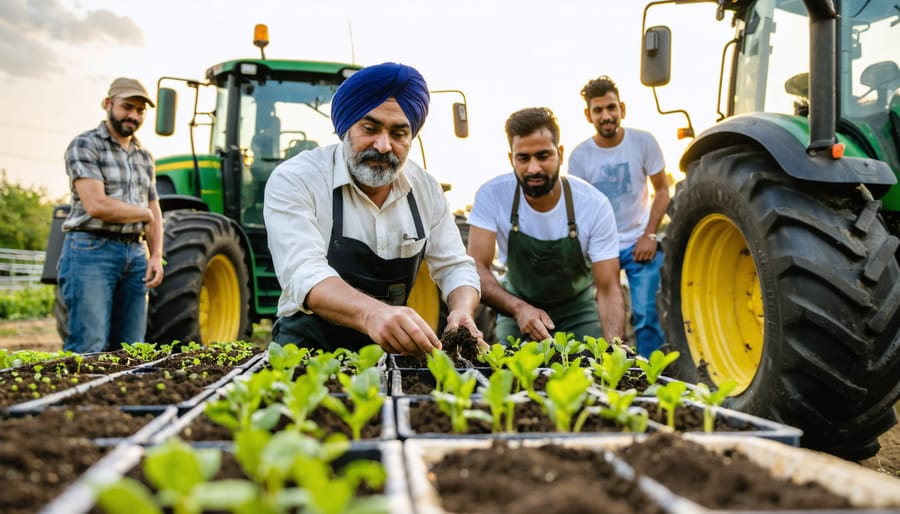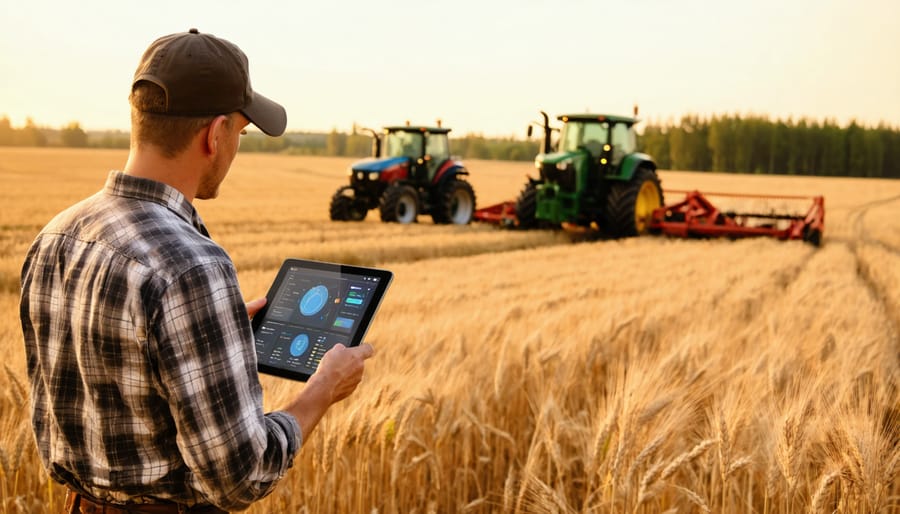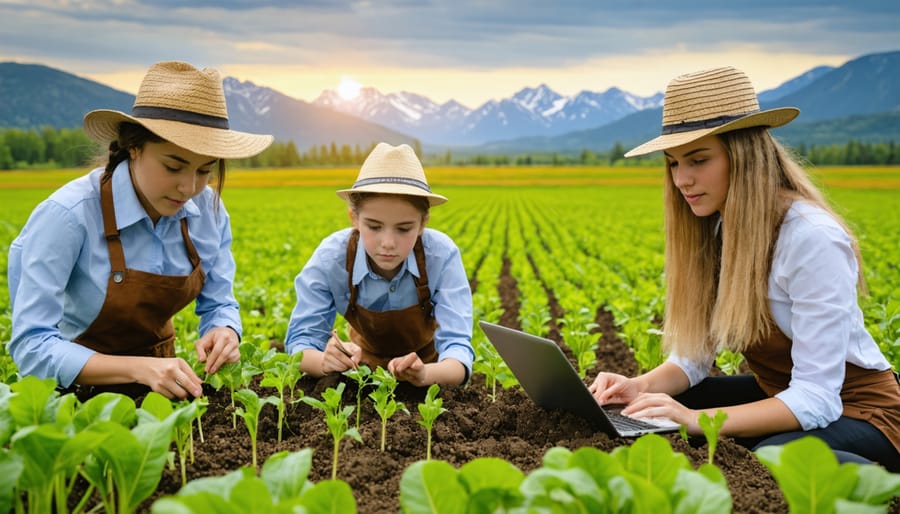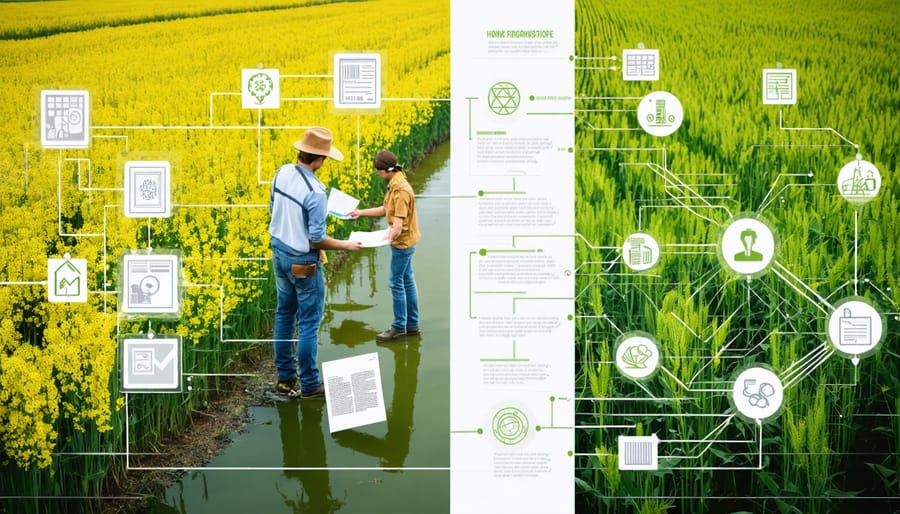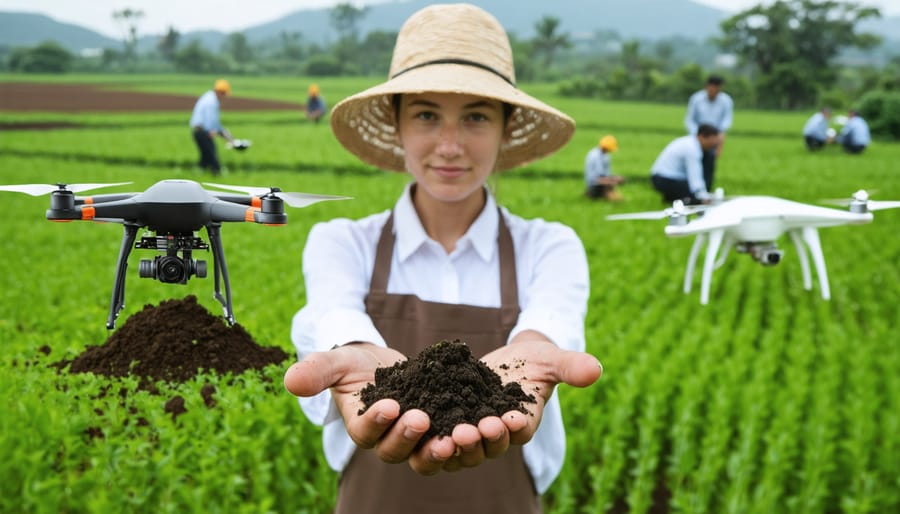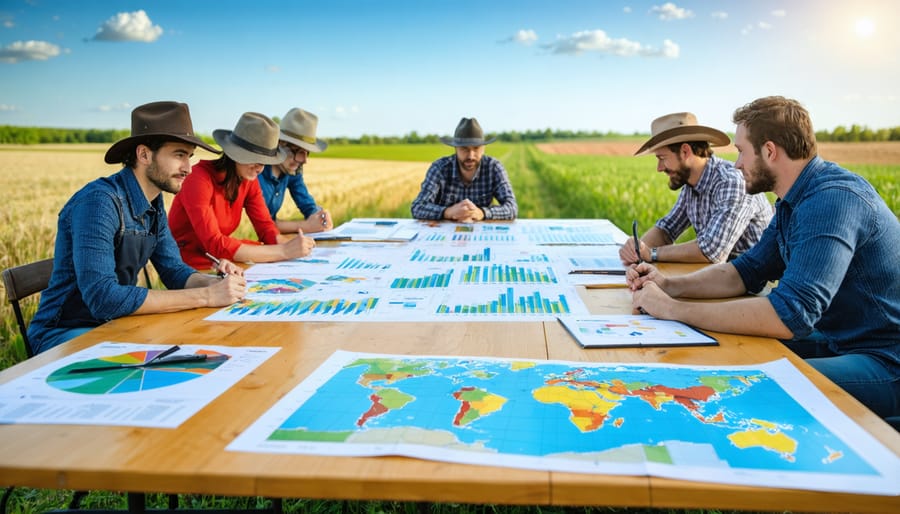Transform your farm management with precision agriculture apps that put real-time data, market insights, and crop monitoring directly in your hands. Today’s farming applications have evolved from simple record-keeping tools into sophisticated platforms that integrate weather forecasting, soil analysis, and equipment tracking—all accessible from your smartphone or tablet.
Canadian farmers are increasingly leveraging these digital solutions to boost yields and reduce operational costs. From small-scale organic operations in southern Alberta to large grain producers in Saskatchewan, mobile farming apps are revolutionizing how we track crop development, manage livestock, and make data-driven decisions.
The impact is clear: farmers using agricultural apps report up to 15% increase in productivity and 20% reduction in input costs. These tools connect directly with soil sensors, weather stations, and equipment telematics, providing instant alerts and recommendations tailored to your specific location and growing conditions.
As sustainable agriculture becomes increasingly crucial, these digital solutions offer precise resource management capabilities while maintaining compliance with Canadian agricultural standards. Whether you’re managing a 5-hectare market garden or a 5,000-hectare grain operation, farming applications serve as your mobile command center for smarter, more efficient agricultural operations.
Smart Farming at Your Fingertips
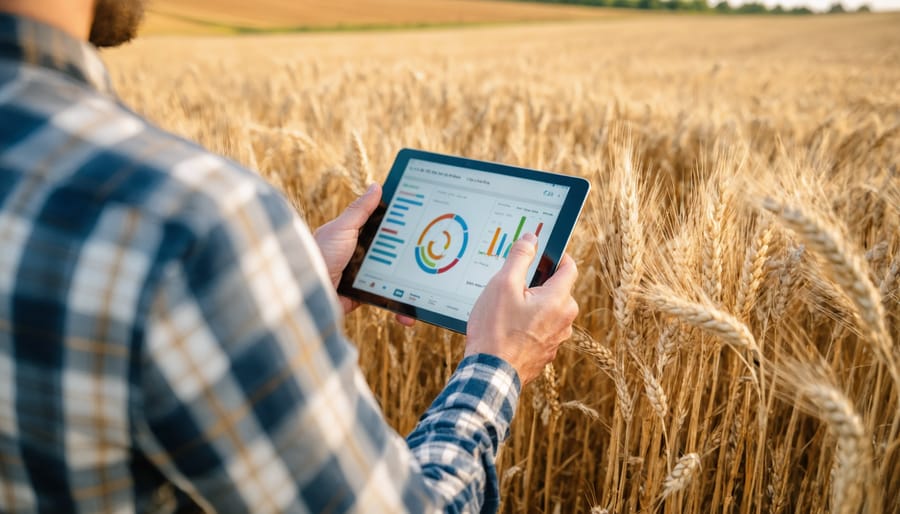
Real-Time Learning Tools
Modern farming success increasingly relies on instant access to knowledge, and today’s digital agronomy tools are making this easier than ever. Apps like Farmers Edge and FarmCommand have revolutionized how Alberta farmers access real-time learning and expert guidance right from their fields.
These tools offer immediate solutions for crop identification, pest management, and soil health assessment through photo recognition and AI-powered analysis. For instance, the Prairie Crop Disease Monitor app, developed specifically for Canadian conditions, allows farmers to instantly identify plant diseases and receive treatment recommendations tailored to local regulations.
Many of these applications feature live chat support with agricultural experts, connecting farmers with specialists who understand Alberta’s unique growing conditions. The Weather Farm app, widely used across the prairies, combines weather monitoring with crop development tracking, helping farmers make informed decisions about timing their operations.
What sets these learning tools apart is their community aspect. Farmers can share experiences, solutions, and best practices through integrated forums and discussion boards. This peer-to-peer learning, combined with expert knowledge, creates a robust support system for both experienced and new farmers.
The best part? Most of these tools work offline, ensuring farmers can access critical information even in areas with limited connectivity – a common challenge in rural Alberta.
Interactive Field Guides
Modern farming has embraced augmented reality (AR) technology through interactive field guide apps that transform how we identify and manage crops, weeds, and pests. These digital tools put expert knowledge right in farmers’ hands, allowing for quick and accurate identification while walking through fields.
Apps like PlantSnap and iNaturalist have become essential tools for Alberta farmers, offering real-time plant identification with impressive accuracy rates above 90%. By simply pointing your smartphone camera at a plant or insect, these apps can instantly provide detailed information about species, growth patterns, and potential threats.
Local farmer Sarah Thompson from Leduc County shares, “These identification apps have revolutionized how we scout our fields. What used to take hours of manual reference checking now takes seconds, letting us respond faster to emerging issues.”
Many of these apps work offline, which is crucial for areas with limited connectivity. They also feature specialized databases of regional crops and pests common to the Canadian Prairies, making them particularly valuable for local agricultural conditions.
Beyond basic identification, these tools often include management recommendations, helping farmers make informed decisions about pest control and weed management strategies. Some apps even allow users to contribute to community databases, creating a valuable network of shared knowledge among Canadian farmers.
Remember to regularly update these apps to access the latest identification features and regional pest alerts specific to Alberta’s growing conditions.
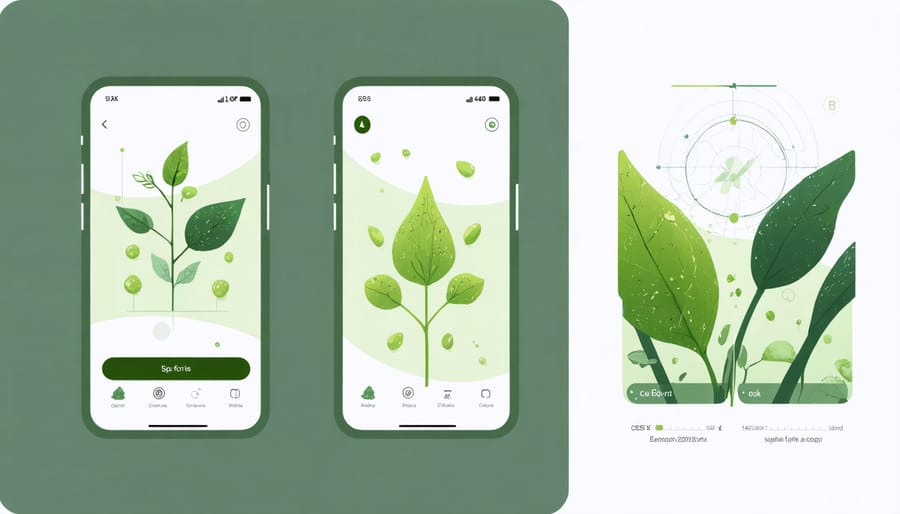
Alberta Success Stories
From Traditional to Tech-Savvy
Meet Sarah Thompson, a third-generation farmer from Olds, Alberta, who’s revolutionizing agricultural practices through mobile learning. Five years ago, Sarah relied solely on traditional farming methods passed down through her family. Today, her 800-hectare operation runs efficiently using various farming apps that help her track everything from soil conditions to equipment maintenance.
“I was skeptical at first,” Sarah admits. “But after attending a digital agriculture workshop in Red Deer, I realized these tools could transform our operation.” She started with basic weather monitoring apps and gradually expanded to comprehensive farm management platforms.
Similarly, Mike Chen, who manages a mixed farming operation near Lethbridge, embraced mobile learning to optimize his crop rotation and livestock management. “The ability to access expert advice and real-time data through my smartphone has been game-changing,” he shares. “I’ve reduced water usage by 30% and improved crop yields significantly.”
The Alberta Agricultural Technology Centre reports that farmers who integrate mobile learning tools see an average 25% increase in operational efficiency. Local success stories include Dave and Linda Peterson, who used crop monitoring apps to detect early signs of disease in their canola fields, preventing potential losses of up to $40,000.
These farmers represent a growing community of tech-savvy agricultural professionals who prove that combining traditional knowledge with mobile learning can lead to more sustainable and profitable farming practices. Their experiences demonstrate that the transition to digital tools, while challenging, offers substantial benefits for Canadian agriculture.
Measuring Real Results
Recent data from the Alberta Agricultural Technology Centre shows that farmers using agricultural apps have reported a 23% increase in productivity and resource management efficiency. Sarah Thompson, a third-generation farmer from Red Deer County, experienced a 15% reduction in water usage after implementing a precision irrigation app on her 400-hectare operation.
“The difference was noticeable within the first growing season,” Thompson shares. “Not only did we save on water, but our crop yield increased by nearly 20% compared to previous years.”
A 2023 survey conducted across Western Canada revealed that 78% of farmers using agricultural apps reported improved decision-making in their daily operations. Notable improvements include:
– 30% reduction in pesticide application through better timing and targeted usage
– 25% decrease in fuel consumption through optimized equipment routing
– 40% improvement in weather-related risk management
– 18% increase in profit margins through better market timing and resource allocation
The Prairie Agricultural Machinery Institute documented multiple success stories, including that of James Morrison, who manages a 2,000-hectare farm near Lethbridge. Using a combination of soil monitoring and crop management apps, Morrison achieved a 28% reduction in fertilizer use while maintaining optimal yield levels.
“The real-time data and analytics have transformed how we operate,” Morrison explains. “We’re making smarter decisions based on actual field conditions rather than gut feelings.”
Training programs implemented by local agricultural extension offices show that farmers who regularly use agricultural apps for at least six months demonstrate significantly improved understanding of sustainable farming practices and achieve better environmental outcomes.
Sustainable Practices Through Mobile Learning
Carbon Footprint Tracking
In today’s climate-conscious agricultural landscape, carbon footprint tracking apps are becoming essential tools for Canadian farmers seeking sustainable farming solutions. These applications help farmers monitor and reduce their environmental impact while maintaining productive operations.
Popular apps like FarmCO2 and CarbonTracker allow farmers to input daily activities, from fuel consumption to fertilizer use, automatically calculating their operation’s carbon emissions. Alberta farmers have reported 15-20% reductions in their carbon footprint after implementing these tracking tools.
Real-time monitoring features enable farmers to identify high-emission activities and make informed decisions about equipment usage, crop rotation, and resource management. For instance, the Smart Farm Carbon Calculator helps users estimate the carbon sequestration potential of different farming practices, such as cover cropping and reduced tillage.
Many of these apps integrate with existing farm management software, making it easier to incorporate carbon tracking into daily operations. They also provide detailed reports that can be valuable for carbon credit programs and environmental certification processes.
Local success stories include the Morrison family farm near Red Deer, which reduced their annual emissions by 25 tonnes after using carbon tracking apps to optimize their equipment usage and implement precision agriculture techniques. These tools not only benefit the environment but often lead to cost savings through improved efficiency.
Soil Health Management
Modern digital tools have revolutionized how Alberta farmers monitor and maintain their soil conditions. From sophisticated soil sensors to user-friendly mobile apps, these technologies make implementing soil health management practices more precise and efficient than ever before.
Popular apps like SoilTest Pro and MySOIL allow farmers to track essential metrics including pH levels, organic matter content, and nutrient availability right from their smartphones. These tools sync with in-field sensors to provide real-time data, helping farmers make informed decisions about fertilization and irrigation schedules.
Local success stories include the Thompson family farm near Red Deer, who reduced their fertilizer use by 20% after implementing smart soil monitoring systems. Their precision agriculture approach combines soil moisture sensors with weather data to optimize irrigation timing and prevent nutrient leaching.
For beginning users, basic soil testing apps offer affordable entry points to digital soil management. These apps typically include features like photo analysis of soil samples, customizable record-keeping, and region-specific recommendations based on soil type and crop requirements.
Many of these tools also integrate with farm management software, creating comprehensive systems that connect soil health data with other aspects of operations. This integration helps farmers develop more sustainable practices while maintaining productive yields.
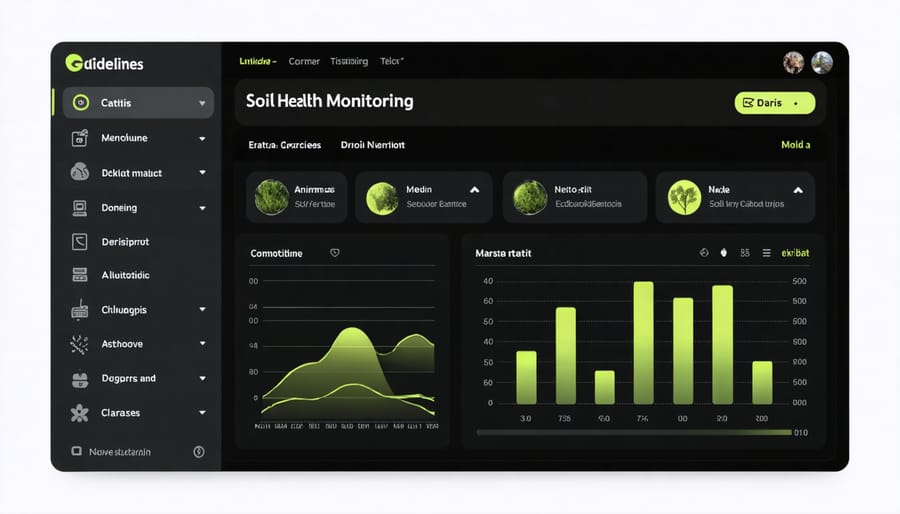
Getting Started with Farm Apps
Starting your journey with farming apps doesn’t have to be overwhelming. Begin by assessing your farm’s specific needs – whether it’s crop management, livestock tracking, or equipment maintenance. Many Canadian farmers find success by starting with one or two essential apps and gradually expanding their digital toolkit.
First, ensure your mobile device meets the basic requirements. Most farming apps work well on newer smartphones or tablets, and many offer offline functionality – crucial for areas with limited connectivity. Consider investing in a rugged case to protect your device during fieldwork.
When selecting apps, look for those offering free trials or basic versions. Popular choices among Alberta farmers include weather monitoring apps, field mapping tools, and pest identification platforms. Read user reviews, particularly from fellow Canadian farmers, to gauge real-world effectiveness.
Start with these practical steps:
1. Download one primary app that addresses your most pressing need
2. Spend 15-20 minutes daily familiarizing yourself with basic features
3. Connect with local farming groups using the same apps
4. Keep a simple log of how the app impacts your daily operations
Many agricultural extension offices in Alberta offer workshops on implementing digital tools. These sessions provide hands-on training and connect you with experienced users in your community. Don’t hesitate to reach out to younger family members or tech-savvy neighbours for additional support.
Remember to regularly back up your data and keep your apps updated. Most importantly, be patient with the learning process. Start small, focus on mastering core features, and gradually explore more advanced capabilities as your confidence grows.
For those concerned about data privacy, review each app’s security settings and terms of service. Many Canadian-developed farming apps prioritize data protection and comply with national privacy standards.
The key to success is choosing tools that genuinely simplify your work rather than complicate it. Focus on apps that offer clear benefits for your specific farming operation and align with your management style.
Mobile agricultural learning apps have revolutionized how Canadian farmers access information and manage their operations. These digital tools have proven invaluable in supporting sustainable farming practices while fostering a more connected agricultural community across Alberta and beyond. The convenience of having expert knowledge, weather updates, and crop management tools at our fingertips has enabled farmers to make more informed decisions and respond quickly to changing conditions.
Looking ahead, we can expect even more innovative features as developers continue to work closely with agricultural professionals to address specific regional needs. Machine learning and artificial intelligence are set to enhance these applications further, offering more personalized recommendations based on local conditions and historical data.
The adoption of farming apps has shown significant benefits, from increased productivity to improved resource management. Many Alberta farmers report saving both time and money while reducing their environmental impact through more precise application of inputs. The community aspect of these platforms has also created valuable networking opportunities, allowing farmers to share experiences and solutions with peers across the country.
For those yet to embrace mobile agricultural learning, now is the perfect time to start. The technology has matured, support networks are well-established, and the potential returns on investment are clear. As we continue to face agricultural challenges, these digital tools will become increasingly essential for maintaining competitive and sustainable farming operations in Canada’s evolving agricultural landscape.

